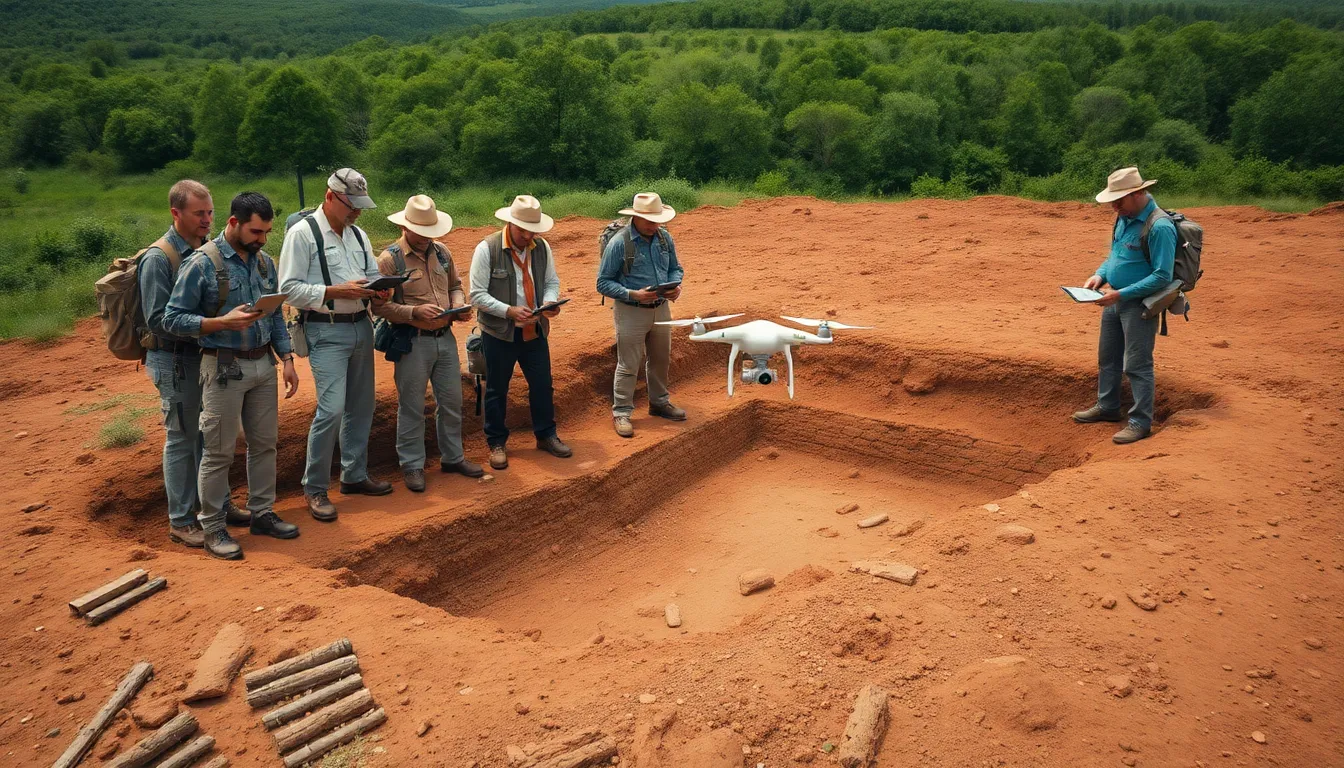In a world where robots are taking over everything from our kitchens to our cars, it’s only fitting they dive into the past too. Enter AI in archaeology, the tech-savvy sidekick that’s revolutionizing how we uncover ancient secrets. Gone are the days of dusty shovels and endless digging; now, archaeologists have a digital partner that can sift through mountains of data faster than you can say “Indiana Jones.”
Table of Contents
ToggleOverview of AI in Archaeology
AI dramatically transforms archaeology by enhancing data analysis capabilities. This technology analyzes large datasets, including satellite imagery and excavation records, at unprecedented speeds. It enables researchers to identify patterns that might remain hidden through traditional methods. Machine learning algorithms play a crucial role in classifying artifacts and determining their historical significance.
AI’s predictive modeling aids in locating potential archaeological sites. By evaluating environmental factors and past excavation results, AI helps prioritize areas for further investigation. Its integration into fieldwork improves the efficiency of archaeological surveys. Drone technology combined with AI provides aerial perspectives, facilitating site documentation without altering landscapes.
Natural language processing also streamlines the review of historical texts and field notes. By converting unstructured data into structured formats, it enhances research efficacy. Researchers can search vast archives quickly, uncovering relevant information that complements fieldwork.
Cognitive computing systems assist in recognizing patterns across numerous artifacts. These systems analyze variations in materials and artistry that indicate cultural exchanges. AI’s contribution extends to dating artifacts through analysis of chemical compositions, leading to more accurate timelines.
The collaboration of interdisciplinary teams, involving computer scientists and archaeologists, fosters innovation. Enhanced training programs help archaeologists learn to operate AI tools effectively. As AI continues to develop, it shapes the future of archaeology, enabling the discovery of ancient secrets with greater speed and insight.
Benefits of AI in Archaeology
AI brings significant advantages to archaeology, streamlining processes and enhancing research outcomes.
Improved Data Analysis
AI empowers archaeologists to process vast datasets rapidly. Analyzing satellite imagery and excavation records now occurs at unprecedented speeds. Hidden patterns emerge more clearly, allowing researchers to classify artifacts effectively. Machine learning algorithms assist in determining the historical significance of discoveries. With enhanced data analysis, researchers better understand artifact distribution and site characteristics.
Enhanced Site Detection
AI’s predictive modeling maximizes the potential for site discovery. Evaluating environmental factors aids in locating potential archaeological sites. Past excavation results inform current research priorities, ensuring efficient allocation of resources. Additionally, drones equipped with AI technology offer aerial perspectives for mapping and documenting sites. These factors combined improve site recognition without altering the landscape, enabling more efficient field investigations.
Challenges of Implementing AI in Archaeology
AI’s integration into archaeology presents various challenges that practitioners face. These issues can hinder the effectiveness of AI applications in the field.
Data Quality and Availability
Quality data remains crucial for effective AI algorithms. In archaeology, data often comes from inconsistent sources, which impacts the reliability of analyses. Limited access to historical records can restrict AI’s predictive capabilities. Further complicating matters, archaeological sites frequently feature incomplete datasets. Researchers must invest in cleaning and standardizing data to ensure accuracy. Improved data sharing among institutions can enhance availability. Robust datasets lead to more reliable AI outputs, ultimately advancing archaeological discoveries.
Ethical Considerations
Ethical implications arise with AI’s integration in archaeology. The potential for misinterpretation or misuse of artifacts exists when relying solely on technology. Preservation of cultural heritage must be prioritized alongside technological advancements. Archaeologists need to establish guidelines for responsible AI use. Engaging with local communities can help mitigate concerns regarding ownership and representation. Transparency in AI decision-making fosters trust among stakeholders. Ultimately, careful ethical considerations promote collaboration and respect for cultural significance while utilizing AI tools.
Case Studies of AI in Archaeology
AI has demonstrated transformative potential in archaeology through various successful implementations and lessons learned from the field.
Successful Implementations
Various projects showcase the effective use of AI technologies. One notable example includes the analysis of satellite imagery to identify ancient agricultural structures in the Near East. Researchers utilized machine learning algorithms to discern patterns in the landscape, leading to the discovery of previously unknown archaeological sites. Another instance involves the automated classification of artifacts found in excavation sites using computer vision tools, significantly speeding up the documentation process. Implementing AI in these projects has not only increased efficiency but also enhanced understanding of historical contexts.
Lessons Learned
Several challenges emerged from applying AI to archaeology. Data quality remains a primary concern, as inconsistent sources can compromise accuracy. Standardizing datasets often became crucial for successful analysis. Ethical considerations regarding artifact representation surfaced, emphasizing the need for community engagement. Overall, the experience highlighted the importance of collaboration between computer scientists and archaeologists. Developing clear guidelines for responsible AI usage proved essential for maintaining cultural sensitivity. Each case underscored the value of a multidisciplinary approach in addressing obstacles faced during AI integration.
Future Prospects of AI in Archaeology
AI’s role in archaeology continues to expand, offering innovative solutions to age-old challenges. Enhanced data analysis capabilities empower archaeologists to extract insights from complex datasets. Predictive modeling looks promising, as it can prioritize potential excavation sites by analyzing environmental variables and historical data.
Interdisciplinary collaboration becomes increasingly important. Computer scientists and archaeologists working together can yield groundbreaking advancements. Enhanced training programs prepare archaeologists to harness AI tools effectively, leading to a more skilled workforce.
Drones equipped with AI offer new perspectives on archaeological sites. Aerial imagery captures site details without disrupting the landscape. This technology streamlines fieldwork and enhances site recognition.
Research outcomes improve through cognitive computing systems. These systems analyze artifacts and identify unseen cultural patterns. Artifact dating becomes more precise with chemical composition analysis, providing clearer historical timelines.
Data quality remains critical. Inconsistent datasets can compromise the efficacy of AI applications. Standards for data cleaning and improved sharing among institutions can elevate research practices.
Ethical considerations also demand attention. Proper guidelines for AI usage must be established to avoid misinterpretation of artifacts. Engaging local communities ensures respect for cultural ownership and representation.
The effectiveness of AI applications in archaeology increases through ongoing case studies. Successful projects illustrate the profound impact of satellite imagery analysis and automated artifact classification. Clear communication among stakeholders fosters a respectful and culturally sensitive approach.
Future advancements hinge on overcoming current challenges. By prioritizing collaboration and ethical considerations, the archaeological field can harness AI’s full potential. Improved, responsible usage of AI tools enhances exploration and deepens understanding of historical narratives.
Conclusion
AI’s integration into archaeology marks a significant shift in how researchers explore and interpret the past. By harnessing advanced data analysis and predictive modeling, archaeologists can uncover hidden patterns and prioritize excavation sites more effectively. The collaboration between computer scientists and archaeologists fosters innovation while addressing challenges related to data quality and ethical considerations.
As AI technology continues to evolve, its potential to transform archaeological practices grows. The field stands at the brink of a new era where ancient secrets can be revealed with unprecedented speed and accuracy. Embracing these advancements responsibly will ensure a deeper understanding of our shared history while respecting cultural significance. The future of archaeology is bright with AI as a key ally in the quest for knowledge.





